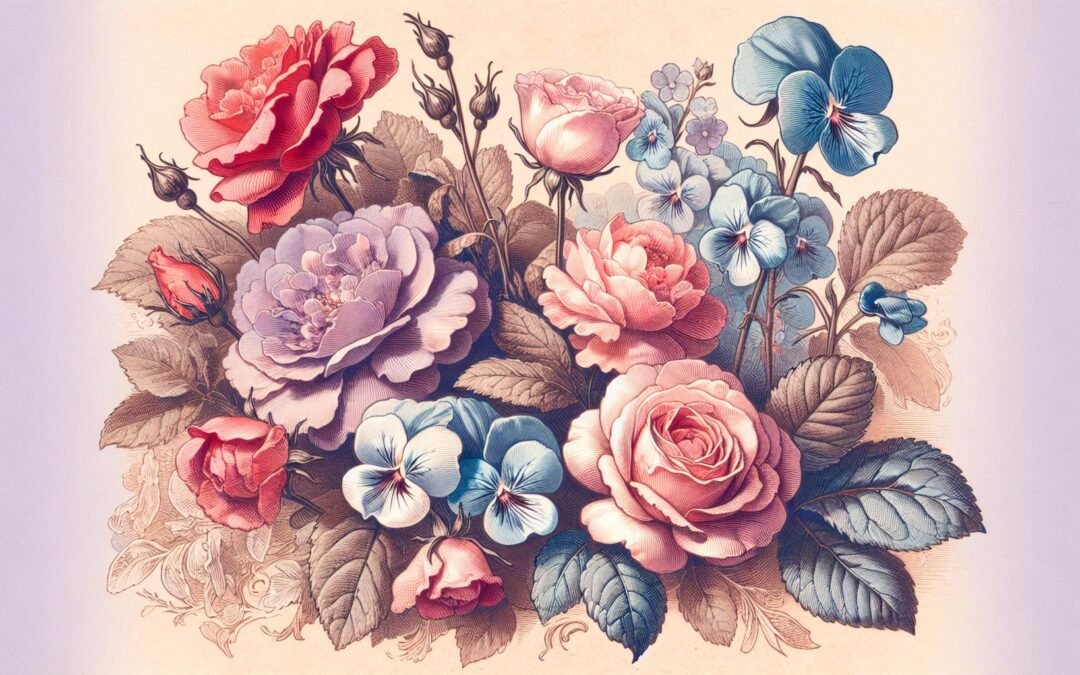Cute roses are red violets are blue poems rest on a heritage of English court and meadow. The tapestry begins with Edmund Spenser’s The Faerie Queene, whose line “She bath’d with roses red, and violets blew” scents the path. This motif, by Shakespeare’s day, blossomed as stanza and song: metaphors of roses, violets, color, and fragrance signaling beauty, tribute, and sweet desire. These floral emblems migrated from odes of high birth to the chiming quatrains cherished in nurseries and parlors. The journey reached a turning point in eighteenth-century chapbooks, where quatrains about roses and violets entered the world of everyday delight and wit, foreshadowing their use on valentines centuries hence. So began a process: the rare emblem of classic poetry grew vibrant in oral tradition and eventually lived anew in greeting cards and playful banter, as discovered in sources such as romantic poems and cherished good morning poems for her. With every retelling, the formula’s adaptability shone brighter—comedy, affection, or gentle ribbing, all within its recognizable lines.
Structure and Aesthetic Powers of Cute Roses Are Red Violets Are Blue Poems
Meter and rhyme perform a courtly dance here. “Roses are red, violets are blue,” iambs lifting the line, yet variants bend the pulse in lively patterns. Quatrains display a couplet-driven AABB rhyme, sometimes flaunting precise echoes, sometimes playing with soft surprise or half-rhyme. The metrical charm springs from the predictability—four-beat lines cushion the mind, encourage choral recitation, become mnemonic spells for young and old. Some renderings, particularly in parodic or youthful versions, chop syllables to bring a jolt of cheer, or extend the cadence to tease with anticipation, as when “Sugar is sweet and so are you” arrives with its honeyed finality. This structure, simple and open, invites creative imitation and impromptu composition; its musicality drifts across centuries and reappears wherever affection or jest seeks a poetic partner. The traditional motif’s presence endures in contemporary collections and in digital anthologies addressing how to write love poetry for all ages.
The Lingua of Innocence and Wit
Language in cute roses are red violets are blue poems deliberately softens. Diminutives (“bunnies,” “ducklings,” “puppies”), affectionate endearments, and images glimpsed plainly through a child’s eyes set the mood. Scenes are safe—a meadow, a picnic, the promise of a shared cookie—where all suggestion of irony remains distant. Colors carry comfort, food transforms into tokens of delight, and pets, rendered vivid in miniature, preside as silent companions. The tune is lilting, light as a skylark, quick to chase shadows from the heart. Whether for children or adults, the result is a poem that makes laughter intimate, joy spontaneous. The voice may echo Shakespearean directness, “Shall I compare thee to a summer’s day?” yet returns from grandeur to the gentle pleasure of present play. Poems become a means for bonding, their beauty described in galleries of best love poetry books and family recitations in libraries.
Childhood, Play, and the Modern Meme
Classroom circles and playgrounds resound with the singing quatrain: “Roses are red, violets are blue” has earned status as an anchor for literacy and improvisation. Children, attuned to rhythm, wield the easy syntax to compose versions starring classmates, holidays, or favorite snacks—“Roses are red, apples are green / You are the best friend I’ve ever seen.” Reading science underscores the utility: the format’s repetition aids sound recognition, strengthens memory, and provides a foundation for rhyme and meter. Picture books—including those by Jane Cabrera—and television series incorporate this template, amplifying its popularity. Poems nestle into countless bedtime and goodnight rituals, sharing sentimental space with goodnight poems for her, fostering bonds by gentle familiarity. Variants abound in animated programs, each voice drawing the rhyme into new forms and keeping the refrain continually fresh.
Digital Playfulness and Memecraft
Online conversation regards cute roses are red violets are blue poems as a catalyst for humor, social kinship, and creative mischief. On platforms from Twitter to TikTok, users rework the pattern for topical jokes, fandoms, or celebrations. A meme may open with classic formula and swerve unexpectedly: “Roses are red, violets are blue / The WiFi is down, so I wrote this for you.” The brevity aligns beautifully with the speed and scale of social media, where short, repeatable texts spread across comment threads, hastening the birth of new micro-traditions. Parody and homage intertwine; participants become playful co-authors. Sometimes threads on forums build to dozens of inventive endings, with communities reveling in the delights of verse. The poem’s fundamental qualities guarantee its viral survival, as documented by internet culture researchers and in the observations recorded in rhyming love poems anthologies.
Emotion, Psychology, and Cultural Adaptation
The magnetic power of cuteness in poetry, studied under Konrad Lorenz’s Kindchenschema—translated as baby schema—emerges through gentle phonemes, rounded sounds, soft consonants, and tender images. These stylistic elements conjure warmth, an instinct to protect, a sense of nostalgia. Whether heard in laughter shared by friends or murmured affectionately to children at rest, the rhyme can synchronize emotions and foster openness. Cuteness encourages readers to lower guard, delight in simplicity, and seek the comfort of the group. Among adults, this poetic formula can be a passage to reminiscence, a light bridge between memory and present affection. Schools and therapists promote the format to support social skills, communication, and confidence, aligning with the playful impulse to invent and participate—methodologies discussed in research journals and in communities highlighting poems about sisters love and shared across romantic poems for wife collections. The emotional rewards, clear in classroom and clinic, ripple beyond youth to embrace the world of the heart.
Global Migration and Reinvention
Traditions resembling cute roses are red violets are blue poems traverse language and land, morphing through local color and custom. French parlance may dwell on “les roses sont rouges, les violettes sont bleues,” while Japanese poets favor a juxtaposition of cherry blossoms or camellias. The Spanish copla and Japanese senryū share brevity, rhythm, and playful surprise, although cultural overtones and turns of affection alter with idiom. Translators find that endearments and poetic forms lose nuance in strict rendition; successful adaptation means infusing local warmth with playful invention. Poems slip easily between print and oral tradition, crossing from child to elder, from village to metropolis. Literary scholars at Poetry Foundation track transformations across continents. Collectors of dirty roses are red poems amuse themselves by tracing bawdy or subversive offshoots tailored for adult laughter, showing the boundless mutability of the English template.
Form, Function, and Mastery in Example
A true exemplar: “Roses are red, bunnies are white / Carrots and kisses bring joy and delight.” Here, color and animal imagery lay a foundation; rhyme unites carrots and affection; the rhythm is musical, familiar as a nursery bell. The economy of the form permits wild invention, where humor or sentiment finds ready expression without confusion or artifice. If the verse calls for play, let it swerve cheerfully—“Roses are red, cookies are round / Joy is much greater whenever you’re found.” Structure remains taut, the rhyme a garland strung from tradition, the meter a pulse that binds the whole. The capacity for sweet temptation and heartfelt surprise, underpinned by centuries of tradition, enriches the world of dirty poems for him and her and contemporary poem for her to make her smile compositions. Simple couplets, innocent or mischievous, share their active charm in every tongue and at every age and rise joyously from collective memory, as fresh and persistent as youth itself.

